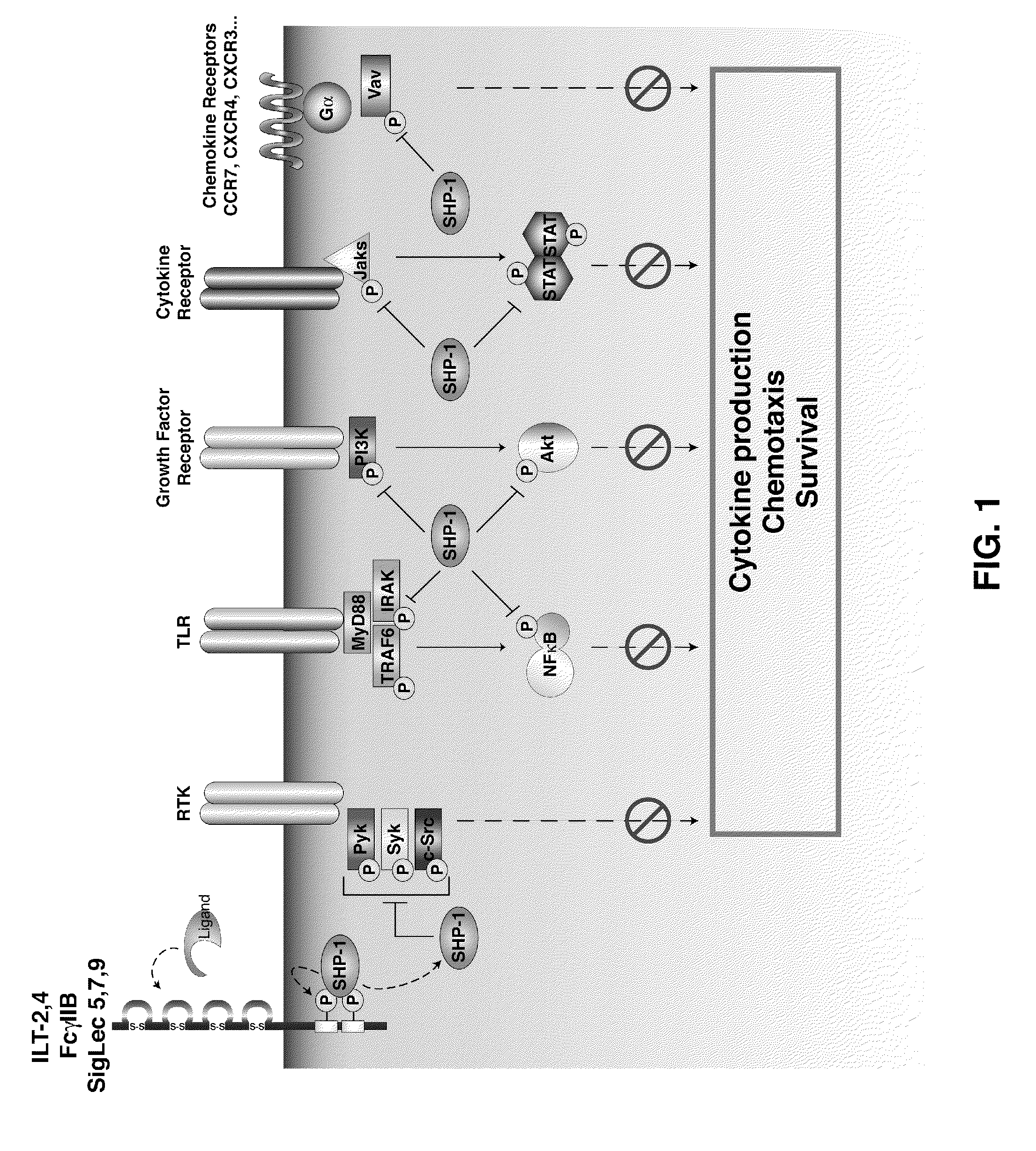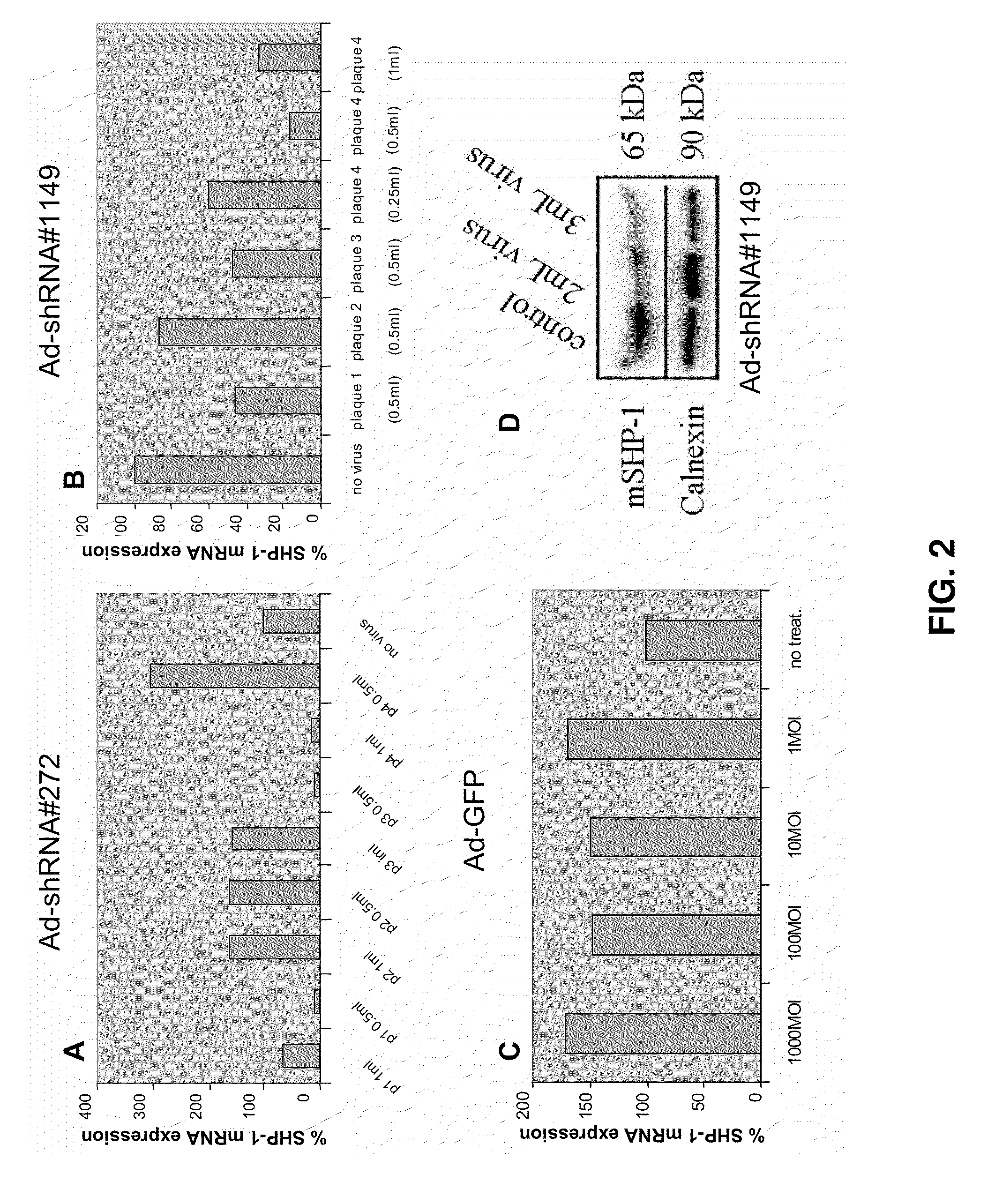Inhibition of the sh2-domain containing protein tyr-phosphatase, shp-1, to enhance vaccines
a technology of protein tyrphosphatase and sh2 domain, which is applied in the field of cell biology, immunology, molecular biology, medicine, can solve the problems of only 18.9 months median life expectancy of patients, only limited efficacy in causing tumor regression, and refractory disseminated hormones
- Summary
- Abstract
- Description
- Claims
- Application Information
AI Technical Summary
Benefits of technology
Problems solved by technology
Method used
Image
Examples
example 1
Exemplary Methods and Reagents to Demonstrate that SHP-1 Inhibition is Effective in Enhancing Anti-Cancer Responses
[0172]Exemplary embodiments of methods and compositions demonstrating that SHP-1 inhibition is effective in enhancing anti-cancer responses are provided herein.
SHP-1 Specific shRNA
[0173]Two mouse SHP-1 specific small hairpin RNAs (shRNA) sequences, 272 and 1149, (referred to by their nucleotide position from the start site of the coding sequence in Genbank mRNA Accession #BC012660) were designed and cloned into the adenoviral vector pAd-BLOCK-iT-DEST RNAi (Invitrogen, Carlsbad, Calif.) which provides U6 polymerase II promoter-driven expression of the shRNA. The exemplary shRNA sequences Ad5-shRNA#1149 (SEQ ID NO:11) and Ad5-shRNA#272 (SEQ ID NO:12) are provided as follows: CACCGGAGCATGACACAGCAGAATACGAATATTCTGCTGTGTCATGCTCC (SEQ ID NO:11) and CACCGCACCATCATCCACCTTAAGTCGAAACTTAAGGTGGATGATGGTGC (SEQ ID NO:12), wherein sequence underlined in the shRNA is the exemplary SHP-1...
example 2
Exemplary Methods and Reagents for Blocking SHP-1 Function
[0202]Exemplary embodiments of methods and compositions demonstrating that SHP-1 inhibition is effective in enhancing anti-cancer responses are provided herein.
[0203]SHP-1 is a significant inhibitor of a number of key signaling pathways crucial for DC activation, migration and antigen processing. Blocking SHP-1 function in DC used as cell-based cancer vaccines enhances their therapeutic efficacy, increasing anti-tumor specific CTL leading to a reduction in tumor burden. The efficacy of SHP-1 inhibited DC vaccines in several murine tumor models including both ectopic and orthotropic prostate cancer is tested. In addition to testing SHP-1 inhibition alone, also test its effect in combination with DC stimulation through an inducible CD40 construct (iCD40) which has been shown to have efficacy against some tumor models.
[0204]Two strategies for inhibiting SHP-1 activity in DC are engineered, small interfering RNA knockdown and ove...
PUM
| Property | Measurement | Unit |
|---|---|---|
| time | aaaaa | aaaaa |
| temperatures | aaaaa | aaaaa |
| volume | aaaaa | aaaaa |
Abstract
Description
Claims
Application Information
 Login to View More
Login to View More - R&D
- Intellectual Property
- Life Sciences
- Materials
- Tech Scout
- Unparalleled Data Quality
- Higher Quality Content
- 60% Fewer Hallucinations
Browse by: Latest US Patents, China's latest patents, Technical Efficacy Thesaurus, Application Domain, Technology Topic, Popular Technical Reports.
© 2025 PatSnap. All rights reserved.Legal|Privacy policy|Modern Slavery Act Transparency Statement|Sitemap|About US| Contact US: help@patsnap.com



